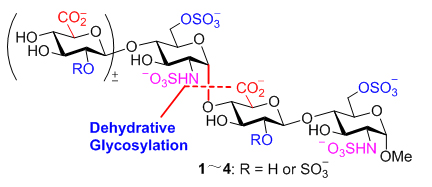摘要/Abstract

乙酰肝素酶(Heparanase,Hpa)是哺乳动物体内的内切葡萄糖醛酸苷水解酶,通过水解葡萄糖醛酸(GlcA)与己胺糖(GlcN)之间的β-糖苷键,选择性地降解肝素和硫酸肝素糖胺聚糖,从而释放多功能的肝素寡糖.本文报道一条高效的肝素酶底物寡糖的合成路线:采用苯甲酰基保护待硫酸化的羟基,苄基保护羧基和裸露的羟基,叠氮基保护氨基,应用脱水糖苷化方法高效地构建关键的a-GlcN-(1→4)-GlcA糖苷键.然后通过标准化的保护基脱除和硫酸化操作,获得肝素酶底物三糖和四糖1-4.最后五步反应的总收率超过52%.肝素酶底物寡糖的合成为研究肝素酶的底物选择性和活性检测打下了基础.
关键词: 乙酰肝素酶, 肝素寡糖, a-(1→4)糖苷键, 脱水糖苷化, 合成
Heparanase, an endo-b-D-glucuronidase responsible for specific cleavage of heparin and heparan sulfates, is relevant to a number of biological processes, such as inflammation, tumor angiogenesis and metastasis. Heparin and heparan sulfate(HS), ubiquitously distributed on the cell surface and in the extracellular matrix, play significant roles in a diverse set of biological processes, including cell growth, virus infection, and tumor metastasis. The substrate specificity of the purified recombinant human heparinase has been investigated, and an optimal tetrasaccharide substrate of heparinase was found to be DHexUA(2S)-GlcN(NS,6S)-GlcUA-GlcN(NS,6S). Here we report an efficient alternative to the chemical synthesis of oligosaccharides relevant to the substrates of heparanase, including the stereoselective construction of a-GlcN-(1→4)-GlcA glycoside bonds and the effective post-assembly manipulations on the fully elaborated oligosaccharides. The dehydrative glycosylation protocol, capitalizing on direct activation of C1-hemiacetals as glycosyl donors, was employed to construct the challenging a-GlcN-(1→4)-GlcA linkages, using diphenyl sulfoxide(Ph2SO)/triflic anhydride(Tf2O) as promoters, 2,4,6-tri-tert- butylpyrimidine(TTBP) as base, toluene as a solvent, and -60 ℃ to room temperature as the working temperature. Under these optimized conditions, mono- and disaccharide donors(9 and 10) and disaccharide acceptors(11 and 12) were condensed to provide the coupled tri- and tetrasaccharides 5~8 in good yields and satisfactory stereoselectivity(>65% yield and a/b>5.4/1.0). The fully elaborated oligosaccharides 5~8 have then been successfully transformed into the target heparin oligosaccharides 1~4 via an effective sequence of manipulation of the protecting groups(>52% yield for 5 steps). The post-assembly manipulations include saponification under Zemplén conditions(for removal of benzyl ester and benzoyl group), O-sulfonation with sulfur trioxide pyridine complex(for hydroxyl groups), reduction and N-sulfonation(for azido group), and high pressure hydrogenation(for removal of benzyl groups). The availability of these heparin oligosaccharides would facilitate in-depth elucidation of the substrate selectivity of heparanase and the development of an effective assay for measuring the heparanase activities.
Key words: heparanase, heparin oligosaccharide, a-(1→4) glycosidic bond, dehydrative glycosylation, chemical synthesis
PDF全文下载地址:
点我下载PDF
